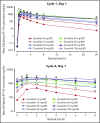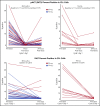Duvelisib, a novel oral dual inhibitor of PI3K-δ,γ, is clinically active in advanced hematologic malignancies
- PMID: 29191916
- PMCID: PMC6033052
- DOI: 10.1182/blood-2017-05-786566
Duvelisib, a novel oral dual inhibitor of PI3K-δ,γ, is clinically active in advanced hematologic malignancies
Abstract
Duvelisib is an oral dual inhibitor of phosphoinositide 3-kinase-δ (PI3K-δ) and PI3K-γ in late-stage clinical development for hematologic malignancy treatment. This phase 1 study evaluated maximum tolerated dose (MTD), pharmacokinetics, pharmacodynamics (PD), efficacy, and safety of duvelisib in 210 patients with advanced hematologic malignancies. In the dose escalation phase (n = 31), duvelisib 8 to 100 mg twice daily was administered, with MTD determined as 75 mg twice daily. In the expansion phase (n = 179), patients with indolent non-Hodgkin lymphoma (iNHL), chronic lymphocytic leukemia (CLL), or T-cell lymphoma (TCL) were treated with 25 or 75 mg duvelisib twice daily continuously. Single-dose duvelisib was rapidly absorbed (time to maximum concentration, 1-2 hours), with a half-life of 5.2 to 10.9 hours. PD results showed inhibition of phospho-AKT (S473) in CLL tumor cells following a single dose and near-complete inhibition of CLL proliferation (Ki-67) by cycle 2. Clinical responses were seen across a range of doses and disease subtypes: iNHL overall response rate, 58% (n = 31) with 6 complete responses (CRs); relapsed/refractory CLL, 56% (n = 55) with 1 CR; peripheral TCL, 50% (n = 16) with 3 CR; and cutaneous TCL, 32% (n = 19). Median time to response was ∼1.8 months. Severe (grade ≥3) adverse events occurred in 84% of patients: neutropenia (32%), alanine transaminase increase (20%), aspartate transaminase increase (15%), anemia and thrombocytopenia (each 14%), diarrhea (11%), and pneumonia (10%). These data support further investigation of duvelisib in phase 2 and 3 studies. This trial was registered at clinicaltrials.gov as #NCT01476657.
© 2018 by The American Society of Hematology.
Conflict of interest statement
Conflict-of-interest disclosure: I.W.F. has received funding/grant support from Acerta Pharma, Agios Pharmaceuticals, BeiGene, Celgene, Constellation Pharmaceuticals, Curis Inc, Forma Therapeutics, Forty Seven Inc., Genentech, Gilead Sciences, Incyte Corporation, Infinity Pharmaecuticals, Janssen Pharmaceutical, Kite Pharma, Merck, Pharmacyclics, Portola Pharmaceuticals, Seattle Genetics, Takeda Pharmaceuticals, TG Therapeutics, Inc., Trillium Therapeutics, Inc., and Verastem Inc. Y.O. received honoraria from Bristol-Myers Squibb and Takeda, and research funding from Infinity Pharmaceuticals, Inc., Rhizen Pharmaceuticals S.A., and Curis Inc. S.H. has received research funding/grant support from Celgene Corporation, Millennium Pharmaceuticals, Inc., Seattle Genetics, Spectrum Pharmaceuticals, Inc., and Infinity Pharmaceuticals, Inc., and consulting fees/honoraria from Celgene Corporation, Millennium Pharmaceuticals, Inc., Seattle Genetics, and Spectrum Pharmaceuticals, Inc. F.F.F. has received consulting fees and funding for a clinical study from Infinity Pharmaceuticals, Inc. K.A., M.D., J.S., and P.K. are former employees of Infinity Pharmaceuticals, Inc. B.K. has received consulting fees from Infinity Pharmaceuticals, Inc., Gilead Sciences, Inc., Pharmacyclics, Roche, Millennium Pharmaceuticals, Inc., Seattle Genetics, and CTI BioPharma. V.M.K. is a former employee of Infinity Pharmaceuticals, Inc., and currently a consultant for Verastem, Inc. The remaining authors declare no competing financial interests.
Figures




Comment in
-
Dual PI3K blockade: PTCL's Achilles heel?Blood. 2018 Feb 22;131(8):839-840. doi: 10.1182/blood-2017-12-820258. Blood. 2018. PMID: 29472370 No abstract available.
References
-
- Okkenhaug K, Bilancio A, Farjot G, et al. . Impaired B and T cell antigen receptor signaling in p110delta PI 3-kinase mutant mice. Science. 2002;297(5583):1031-1034. - PubMed
-
- Vanhaesebroeck B, Guillermet-Guibert J, Graupera M, Bilanges B. The emerging mechanisms of isoform-specific PI3K signalling. Nat Rev Mol Cell Biol. 2010;11(5):329-341. - PubMed
-
- Fung-Leung WP. Phosphoinositide 3-kinase delta (PI3Kδ) in leukocyte signaling and function. Cell Signal. 2011;23(4):603-608. - PubMed
-
- Peluso M, Faia K, Winkler D, et al. . Duvelisib (IPI-145) inhibits malignant B-cell proliferation and disrupts signaling from the tumor microenvironment through mechanisms that are dependent on PI3K-δ and PI3K-γ. Blood. 2014;124:328. - PubMed
Publication types
MeSH terms
Substances
Associated data
Grants and funding
LinkOut - more resources
Full Text Sources
Other Literature Sources
Medical
Miscellaneous

